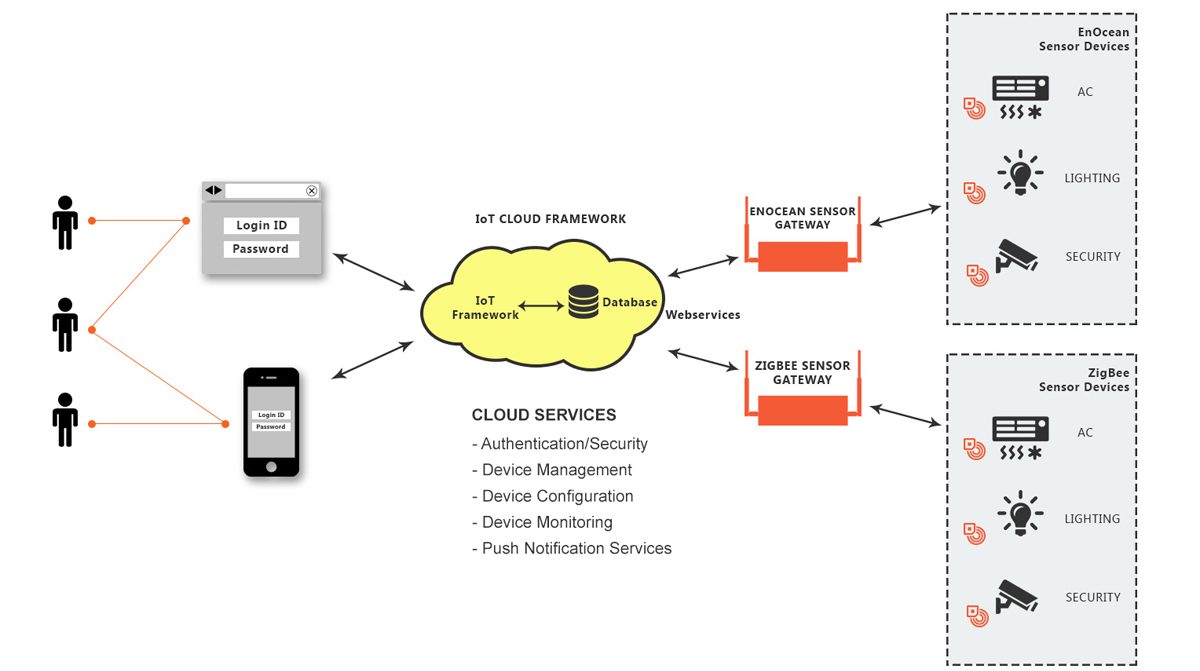If you haven’t been living under a rock, you would be familiar with the Internet of Things (IoT). IoT is the technological advancement that is set to bring about a major change in our day-to-day lives. End to end IoT solutions include devices fitted with sensors, IoT cloud platform, user interfaces and sometimes, IoT gateways that provide a host of additional benefits.
IoT solutions are not just limited to domestic and commercial applications; the extensive benefits these offer in Industry 4.0 are set to revolutionize the efficiency of manufacturing technologies and processes. With IoT cited as the next big thing for enterprises and industries, businesses are actively investing in the setup of full-stack IoT platforms.
Understanding an IoT Solution
IoT is a network of things, which may be your phone, tablet, lighting system in your house, or your home appliances; all connected and interacting with each other. In an industrial set up, IoT can establish connectivity between machines, devices and user interface systems on the factory floor.
Effective connectivity between IoT enabled devices and the Cloud platform is provided by IoT gateways. The internet is the backbone of IoT connectivity solutions, as this forms the medium for data to flow seamlessly from one end of the network to the other.

Use Cases of IoT
- Smart grid and smart metering solutions
Gone are the days when power company employees used to come to your houses to take note of the meter readings and consequently generate a bill based on your consumption. Not only was this process time consuming, but also inaccurate at times.Smart grid and smart metering solutions are a step towards reducing manual work and providing accurate information to the consumers. With a smart metering IoT solution you can accurately monitor your power consumption on a daily basis on web portals. At the same time, no manual work is required for taking these readings.
These smart meters send real-time information to IoT gateways that forward this data to the cloud, and subsequently to web portals from where users can access it. With the integration of payment gateways on web portals, even bill payment can be done in seconds.
- IoT enabled home automation systems
Home automation systems were meant for high-end audiences and have traditionally cost a fortune. But IoT has made this a reality for the common man through affordable solutions.In an IoT enabled home automation system, all your appliances would be connected to the internet using an IoT gateway. Typically, you would be able to use a device, like a phone, to control all such appliances. Let’s just say we want to turn on the air conditioner; this can be done through the phone which relays the “switch-on” command through the internet to the IoT gateway and finally to the air conditioner.
- Asset tracking solutions
Today, it’s possible to know the real-time location of the item you purchased online. The logistics industry has leveraged the power of IoT solutions to open new horizons of customer interaction.The industry relies on a robust IoT platform solution to bring data to customers on their fingertips. It is no more a roadblock. It’s safe to say that with IoT enabled solutions it’s now feasible to track real-time locations of assets, and that too on any device with a browser and an internet connection.
- Predictive maintenance
This is one of the most notable use cases of IoT in industrial applications. Through the use of sensors and data analytics, it is possible to determine the operational efficiency of a device and predict failure of the device even before it actually happens.The failure warnings can be monitored by managers and service/maintenance timelines are charted out before any problems surface. Predictive maintenance brings about a significant reduction in operational expenses, and equipment monitoring is turned into an automated process.
- Vehicle automation
Smart vehicles are no longer a figment of our imagination. With connected digital instrument clusters ruling the automotive market, vehicle automation is an inherent part of the mobility industry.Connected vehicles communicate with cloud servers using IoT gateways that are backed by 3G or 4G Internet connectivity. Vehicle communication can also be established with end-user applications through Bluetooth tethering over protocols like CAN, LIN, FlexRay, Ethernet, etc.
These are just a few examples of the potential that IoT based solutions hold.
From these use cases you would have noticed that the IoT gateway plays an important role in end to end IoT solutions. The efficiency of the network is mainly governed by the IoT gateway devices.
Critical Aspects of an IoT Gateway
IoT gateway is an important element to consider when it comes to designing full stack IoT solutions. IoT gateways are more than just bridges that transmit data; they form the backbone of any IoT solution, and several features make this capability possible:
- Data logger
Gateway devices are capable of logging the data collected from multiple IoT enabled devices. This becomes an integral feature when it comes to developing countries where internet connections are not very fluid. - Flexible connectivity solutions
The beauty of IoT connectivity solutions is the inclusiveness of heterogeneous devices that can become part of the network.IoT gateways come with a variety of interfaces like LoRaWAN, NBIoT, Bluetooth, GPRS and Wi-Fi, to name a few. So, whatever may be the interface, we can always align our gateway to these devices to provide a robust IoT connectivity solution.
- Over-the-air (OTA) updates
It is an absolute necessity nowadays that IoT devices should incorporate over-the-air firmware updates. It is not possible for vendors to physically install updates in each device since these might be deployed at different geographical locations.Over-the-air updates provide a flexible solution to this problem from the perspective of the consumer as well as the vendor. Updates are frequent and easy to install with IoT gateways that are provided with OTA firmware update feature.
- Robust design to handle harsh environmental conditions
IoT gateway devices may be deployed in varying conditions depending on the particular application sector for which they are targeted. These gateways are hence, designed to withstand harsh environmental conditions like rain and high temperature the summer, for long periods of time. - Flexible data on cloud
An IoT gateway’s primary work is to relay data from IoT enabled devices to the cloud. If you consider it this way, it acts as a packet forwarder. Gateways offer flexible data formats and protocols like MQTT that can be used to forward data to cloud platforms in whatever protocol or format they need.
Features like licensing and data security make IoT gateway devices ready for many real-world applications.
A Brief Look at IoT Gateway Security
With more and more IoT enabled devices being connected to the internet, the possibilities of the network becoming vulnerable to cyber crimes are on the rise. The last thing you want is hackers getting into the system and taking control.
Thankfully, there’s no need to worry. IoT gateway devices are meant to provide a secure channel for data exchange that is not susceptible to hacking.
Gateway solutions offer security features like end-to-end encrypted data packets, device registration, and cryptograph level security. While these are generally followed practices when it comes to securing IoT gateways, technologies like TLS/SSL encryption and AES cipher suites are witnessing widespread adoption.
Additionally, experts suggest using true end-to-end application layer security through which messages are encrypted such that only unique recipients are able to decrypt them.
Another sleek technique that can be used is secure on-boarding which involves imprinting a device being enrolled in an IoT solution with a cryptographic key generated by the IoT management service.
Wrapping It Up
IoT offers viable solutions for various domains like defense, agriculture, home automation and industrial manufacturing. People might be under the impression that there is more hype than reality in the capabilities of IoT, but the truth is far from that.
Despite these facts, it may be highly difficult to predict by when IoT will become a reality on a larger commercial scale. The solutions will need to evolve on a daily basis, learning and adapting to cyber threats. An important element to consider while choosing an IoT solution is the gateway, as this will be vital to efficiency and security.


